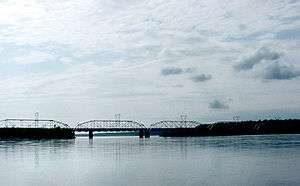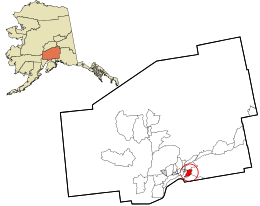Butte, Alaska
Butte is a census-designated place (CDP) in Matanuska-Susitna Borough, Alaska, United States. It is part of the Anchorage, Alaska Metropolitan Statistical Area. At the 2010 census, the population was 3,246, up from 2,561 in 2000. Butte is located between the Matanuska River and the Knik River, approximately 5 miles (8 km) southeast of Palmer. It is accessible via the Old Glenn Highway.
Butte, Alaska | |
|---|---|
 Railroad bridge on Knik River, from the Old Glenn Highway on south side of Butte | |
 Location in Matanuska-Susitna Borough and the state of Alaska. | |
| Coordinates: 61°32′53″N 149°1′36″W | |
| Country | United States |
| State | Alaska |
| Borough | Matanuska-Susitna |
| Government | |
| • Borough mayor | Vern Halter |
| • State senator | Bill Stoltze (R) |
| • State rep. | Cathy Tilton (R) |
| Area | |
| • Total | 41 sq mi (106.3 km2) |
| • Land | 40.3 sq mi (104.3 km2) |
| • Water | 0.7 sq mi (1.9 km2) |
| Elevation | 92 ft (28 m) |
| Population (2010) | |
| • Total | 3,246 |
| Time zone | UTC-9 (Alaska (AKST)) |
| • Summer (DST) | UTC-8 (AKDT) |
| Area code(s) | 907 |
| FIPS code | 02-09710 |
| GNIS feature ID | 1416898 |
Education
Butte has its own elementary school, although the closest high school is Palmer High School.
Recreation
The town of Butte surrounds the geological formation Bodenburg Butte (Hutnaynut'i in the indigenous Dena'ina language), from which the town draws its name. There are two hikes to the 900-foot summit, which offers 360-degree views of the surrounding Matanuska Valley and distant Knik Glacier.
Located within town is the Knik River Public Use Area (KRPUA), which provides a full spectrum of outdoor recreational opportunities and is open to motorized and non-motorized recreational pursuits. Activities common to the area include riding off-highway vehicles (OHVs), hunting, fishing, trapping, target shooting, boating, flying planes, horseback riding, biking, hiking, camping, and wildlife viewing.[1]
Butte is also home to the Alaska Raceway Park, which has been operating for more than 50 years. The track holds races from Mother’s Day until Labor Day and most between.[2] The 1/3 mile asphalt oval track is certified for NASCAR races in the Whelen All American Series.[3]
Located on the southern flank of the Bodenburg Butte is the Williams Reindeer Farm, which has been operating since 1987. The Reindeer farm is featured in an episode of Discovery's Dirty Jobs.[4]
Economy
The economic backbone of Butte is a substantial agricultural network of producing farms as well as the State of Alaska Plant Materials Center.[5] Organic and conventional farms in the area supply a bounty of produce to the local farmer's markets of the surrounding areas.
A variety of other small businesses in the area include equestrian centers, coffee shops and restaurants, and a boatbuilder.
Geography
Butte is located at 61°32′53″N 149°1′36″W (61.548030, -149.026617).[6]
According to the United States Census Bureau, the CDP has a total area of 41.0 square miles (106 km2), of which 40.3 square miles (104 km2) of it is land and 0.7 square miles (1.8 km2) of it (1.80%) is water.
Demographics
| Historical population | |||
|---|---|---|---|
| Census | Pop. | %± | |
| 1960 | 559 | — | |
| 1970 | 448 | −19.9% | |
| 1980 | 988 | 120.5% | |
| 1990 | 2,039 | 106.4% | |
| 2000 | 2,561 | 25.6% | |
| 2010 | 3,246 | 26.7% | |
| U.S. Decennial Census[7] | |||
Butte first appeared on the 1960 U.S. Census as an unincorporated village.[8] In 1980, the name was changed to "Bodenburg Butte" and was made a census-designated place (CDP).[9] In 1990, the name reverted to Butte.[10]
As of the census[11] of 2000, there were 2,561 people, 884 households, and 671 families residing in the CDP. The population density was 63.6 people per square mile (24.5/km2). There were 964 housing units at an average density of 23.9/sq mi (9.2/km2). The racial makeup of the CDP was 92.50% White, 0.51% Black or African American, 2.89% Native American, 0.12% Asian, 0.08% Pacific Islander, 0.51% from other races, and 3.40% from two or more races. 1.25% of the population were Hispanic or Latino of any race.
There were 884 households, out of which 37.8% had children under the age of 18 living with them, 62.6% were married couples living together, 7.7% had a female householder with no husband present, and 24.0% were non-families. 19.3% of all households were made up of individuals, and 4.8% had someone living alone who was 65 years of age or older. The average household size was 2.89 and the average family size was 3.28.
In the CDP, the population was spread out, with 30.5% under the age of 18, 7.4% from 18 to 24, 29.2% from 25 to 44, 25.7% from 45 to 64, and 7.3% who were 65 years of age or older. The median age was 36 years. For every 100 females, there were 106.9 males. For every 100 females age 18 and over, there were 106.7 males.
The median income for a household in the CDP was $55,573, and the median income for a family was $58,796. Males had a median income of $46,298 versus $32,933 for females. The per capita income for the CDP was $22,522. About 7.2% of families and 9.8% of the population were below the poverty line, including 15.8% of those under age 18 and 3.5% of those age 65 or over.
References
- "Knik River Public Use Area". dnr.alaska.gov. Retrieved 2016-01-01.
- "Alaska Raceway Park | Celebrating 51 years of racing". www.alaskaracewaypark.com. Retrieved 2016-01-01.
- http://www.adn.com/sports/2016/05/27/driving-in-circles-alaska-raceway-park-debuts-nascar-approved-oval/
- "Reindeer Farm". Discovery. Retrieved 2016-02-04.
- "Alaska Plant Materials Center | State of Alaska | Department of Natural Resources | Division of Agriculture". plants.alaska.gov. Retrieved 2015-12-31.
- "US Gazetteer files: 2010, 2000, and 1990". United States Census Bureau. 2011-02-12. Retrieved 2011-04-23.
- "U.S. Decennial Census". Census.gov. Retrieved June 6, 2013.
- https://www2.census.gov/prod2/decennial/documents/37721577v1p3ch2.pdf
- https://www2.census.gov/prod2/decennial/documents/1980a_akABCD-01.pdf
- https://www.census.gov/prod/cen1990/cph5/cph-5-3.pdf
- "U.S. Census website". United States Census Bureau. Retrieved 2008-01-31.
